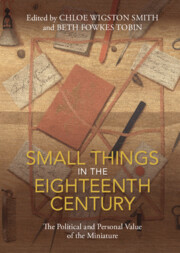Book contents
- Small Things in the Eighteenth Century
- Small Things in the Eighteenth Century
- Copyright page
- Contents
- Figures
- Notes on Contributors
- Acknowledgments
- Introduction
- Part I Reading Small Things
- Part II Small Things in Time and Space
- 5 On the Smallness of Numismatic Objects
- 6 Crinoidal Limestone and Staffordshire Teapots
- 7 “Joineriana”
- 8 “Pray What a Pox Are Those Damned Strings of Wampum?”
- Part III Small Things at Hand
- Part IV Small Things on the Move
- Afterword
- Select Bibliography
- Index
8 - “Pray What a Pox Are Those Damned Strings of Wampum?”
British Understandings of Wampum in the Eighteenth Century
from Part II - Small Things in Time and Space
Published online by Cambridge University Press: 29 September 2022
- Small Things in the Eighteenth Century
- Small Things in the Eighteenth Century
- Copyright page
- Contents
- Figures
- Notes on Contributors
- Acknowledgments
- Introduction
- Part I Reading Small Things
- Part II Small Things in Time and Space
- 5 On the Smallness of Numismatic Objects
- 6 Crinoidal Limestone and Staffordshire Teapots
- 7 “Joineriana”
- 8 “Pray What a Pox Are Those Damned Strings of Wampum?”
- Part III Small Things at Hand
- Part IV Small Things on the Move
- Afterword
- Select Bibliography
- Index
Summary
Wampum beads are small beads made out of shellfish, typically the quahog clam, which were traditionally used by various First Nations in acts of ceremony, memory, and exchange. Often placed together on strings or woven into large belts displaying patterns, wampum was exchanged among various Indigenous nations of the Eastern Seaboard and beyond. It became a very important trade object with Europeans, who spread its use across colonial economies. For British writers in the eighteenth century, it was a perplexing material; for some it was understood as a form of currency, roughly translatable to a European economic system of monetary exchange. Others understood wampum as writing, not legible to the European but which contained in its strings of beads a cultural history or account of a treaty negotiation, or more simply a pledge of fidelity. Its additional use as an object of adornment further complicated any stable understanding; as both text and commodity, sacred pact and ornament, wampum conflated systems of meaning and challenged European epistemologies. This chapter will look at various interpretations of wampum and will assess the epistemological challenges it placed to a society in which the lines between finance and culture were becoming increasingly blurred.
Keywords
- Type
- Chapter
- Information
- Small Things in the Eighteenth CenturyThe Political and Personal Value of the Miniature, pp. 125 - 140Publisher: Cambridge University PressPrint publication year: 2022

